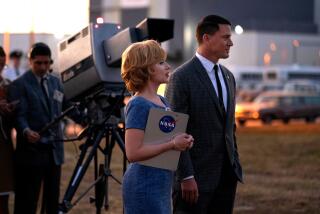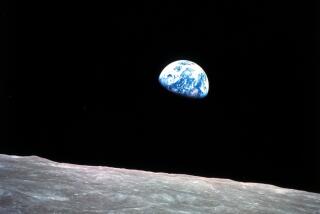Apollo’s rationalist
- Share via
AT the beginning of “Magnificent Desolation,” Tom Hanks’ recent IMAX movie about the Apollo moon landings, a group of schoolchildren tell what they know about lunar travel, which isn’t much. When asked about the order in which U.S. astronauts arrived on the moon, for instance, one little girl insists that Lance Armstrong came first.
Clearly, what the world needs is a good biography of astronaut Neil Armstrong, who, on July 20, 1969, planted the first human foot -- or rather, pressurized boot -- on lunar soil. And at nearly 800 pages, James R. Hansen’s “First Man” seemed likely to fill that need. Hansen, a professor at Auburn University and a former historian for NASA, interviewed more than 125 people for the book and logged more than 50 hours with the famously laconic Armstrong. His exhaustive research, however, may have been his undoing. Hansen has presented what he knows with little apparent sifting, shaping or pruning. “First Man” is not so much reported and written as vacuumed up and dumped out.
Still, many gems twinkle amid the irrelevancies and rambling quotations. And if readers can weather the turgid opening chapters, including a lengthy digression on a 17th century Irishman to whom Armstrong’s mother falsely thought him related, they may enjoy the sections taking place in space. Hansen’s hyper-detailed style -- featuring long transcripts of in-flight conversations and such near-trivia as Armstrong’s heart rate under stress -- works when applied to events on the moon, where what happens from second to second has some import.
Armstrong was born in 1930 in Wapakoneta, Ohio, an archetypal small town with archetypal small-town values. From a young age, his scientific rationalism set him apart. His mother, Viola, was an ardent Christian, but he rejected her orthodoxy and by high school was calling himself a “Deist.” His interest in aviation also emerged early. He earned his pilot’s license well before his driver’s license and at age 16 flew himself to West Lafayette, Ind., to preregister for classes at Purdue. In 1955, after interrupting his studies with a stint as a naval aviator, he earned a bachelor’s degree in aeronautical engineering.
As Hansen tells it, the college-educated pilots of the Apollo program were far from “Spam in a can” -- mere passengers with little control over their spacecraft; their engineering knowledge was vital to their work. This puts him at odds with Tom Wolfe, whose “The Right Stuff” romanticizes such seat-of-the-pants Air Force pilots as Chuck Yeager, who scorned Project Mercury’s wingless capsules and was barred from the astronaut program because he lacked a college degree. Hansen refutes Wolfe’s portrayal of Yeager as the first to fly an airplane into the high stratosphere and discredits Yeager’s account, in his autobiography, of a 1962 flight with Armstrong in a two-seat training plane. Yeager questions the future astronaut’s flying skills, and Hansen wildly overreacts to this criticism, devoting pages to its rebuttal. He also makes much of Armstrong’s war record. While serving in combat in Korea, the young flier did indeed keep his cool through multiple brushes with death. Yet Hansen’s plodding narration strips the drama from these incidents. One wishes his admirable concern with accuracy were paired with Wolfe’s irresistible storytelling.
Armstrong’s robotic stoicism, which served him well in combat, had a different effect at home. In 1956, he married Janet Shearon, a physician’s daughter from Wilmette, Ill., whom he had met at Purdue. He was attracted by “her smarts, her good looks, and her lively personality,” all of which he managed, through neglect, to diminish. The smarts suffered first. After exchanging vows, the couple moved to California, where Armstrong had a job as a test pilot at the NACA (National Advisory Committee for Aeronautics) High-Speed Flight Station in the desert near Edwards Air Force Base. The couple rented a place in Westwood, close to UCLA, so Janet could complete her undergraduate degree. But tired of commuting, Armstrong soon moved her closer to his work, ending her education. Later, when their 2-year-old daughter died from an inoperable brain tumor, Janet “desperately needed her husband to help her,” commented the wife of another test pilot, but Armstrong, using “work as an excuse ... got as far away from the emotional thing as he could.” For more than three decades, Janet ignored his inattention. In November 1987, however, she could deny it no more: “I asked him to go skiing, but he couldn’t work it into his schedule for another year.” In 1990, she initiated a divorce. Armstrong, only briefly fazed, swiftly remarried.
Whereas Hansen’s attacks on Yeager seem gratuitous, his account of Buzz Aldrin’s campaign to be the first man out of the lunar lander is thoroughly entertaining. Astronaut Gene Cernan told Hansen that Aldrin “worked himself into a frenzy” over the issue and “came flapping into my office at the Manned Spacecraft Center one day like an angry stork,” insisting that he, not Armstrong, be first down the ladder. “How Neil put up with such nonsense,” Cernan added, “is beyond me.” The conflict continued on the moon. Armstrong snapped many photographs of Aldrin, but Aldrin took none of Armstrong. Nor did the two see eye to eye on religion. Armstrong refused to cite a denominational preference on his astronaut application (causing the notorious unbeliever Madalyn Murray O’Hair to rejoice in his supposed atheism); in contrast, Aldrin took along a vial of wine and a wafer to the moon for a Communion ceremony.
Hansen’s disparagement of such writers as Wolfe does not extend to Norman Mailer, whose riveting “Of a Fire on the Moon” he quotes at length. In a few well-chosen words, Mailer distills what strikes me as Armstrong’s essence: his “mixture of modesty and technical arrogance, of apology and tight-lipped superiority.” Mailer also takes note of Armstrong’s mastery of “computerese” and his preference for pretentious convolutions over clear, simple English: Instead of saying “we,” Armstrong says, “A joint exercise has demonstrated.... “ Instead of “other choices,” he prefers “peripheral secondary objectives.” After his flight in Gemini 8, Armstrong chided Life magazine for conveying the facts in “an overly jazzy way,” as though accuracy and dramatic storytelling were incompatible. Hansen seems to share this view, which no doubt pleases his subject but may disappoint his audience. *
More to Read
Sign up for our Book Club newsletter
Get the latest news, events and more from the Los Angeles Times Book Club, and help us get L.A. reading and talking.
You may occasionally receive promotional content from the Los Angeles Times.









